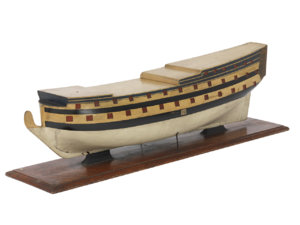Today in Naval History - Naval / Maritime Events in History
7th of March
please use the following link and you will find the details and all events of this day .....
1665 - HMS London (76) blew up in an accident and sank in the Thames estuary.
London was a 76-gun second-rate ship of the line in the Navy of the Commonwealth of England, originally built at Chatham Dockyard by shipwright John Taylor, and launched in June 1656. She gained fame as one of the ships that escorted Charles IIfrom Holland back to England during the English Restoration, carrying Charles' younger brother James Duke of York, and commanded by Captain John Lawson.
London was accidentally blown up in 1665 and sank in the Thames Estuary.[2] According to Samuel Pepys 300 of her crew were killed, 24 were blown clear and survived, including one woman. Lawson was not aboard at the time of the explosion but many of his relatives were killed.

The wreck of London

1757 – Launch of HMS Princess Amelia, an 80-gun third rate ship of the line of the Royal Navy
HMS Princess Amelia was an 80-gun third rate ship of the line of the Royal Navy, built at Woolwich Dockyard to the draught specified by the 1745 Establishment, and launched on 7 March 1757.
She participated in the 1781 Battle of Dogger Bank under the command of Captain Macartney with reduced masts and guns.
Princess Amelia was lent to the Board of Customs in November 1788, and thereby deleted from the Navy List. She arrived at Sheerness on 24 March 1818 from Stangate Creek. The Admiralty then sold her on 11 June 1818 to a Mr. Snooks for £2,610.

1765 – Launch of The San Zaccharia, a 64-gun ship of the line of the Navy of the Order of Saint John of Malta, later brought into French service as the Dégo.
The San Zaccharia was a 64-gun ship of the line of the Navy of the Order of Saint John of Malta, later brought into French service as the Dégo.

A model of an 18th-century third-rate of the Order of Saint John, similar to the San Zaccharia
1765 Launch of Artésien (“Artesian”), a 64-gun ship of the line
Artésien (“Artesian”) was a 64-gun ship of the line of the French Navy, lead ship of her class. She was funded by a don des vaisseaux donation from the Estates of Artois.
Artésien was built in 1765 as a part of a series of twelve ships of the line began by Choiseul to compensate for the losses endured by the French Royal Navy during the Seven Years' War. She was paid by the province of Artois and Flander, and named in its honour, according to the practice of the time.
Artésien took part in the American revolutionary war under Suffren, departing in 1781. Off Cape Verde, Artésien detected an English squadron, resulting in the Battle of Porto Praya.
Artésien was decommissioned in 1785 and used as a shear hulk.
A fine 1/28th scale model was used to instruct Louis XVI in naval studies. The model is now on display at the Musée de la Marine.

1778 - Continental frigate USS Randolph (32) explodes while attacking HMS Yarmouth (64) off the coast of Barbados, killing all but four of her 315 crew.
On the afternoon of 7 March, Randolph's lookouts spotted sail on the horizon. At 21:00 that evening, that ship, now flying British colors, came up on the Randolph as the largest ship in the convoy, and demanded they hoist their colors. The Randolph then hoisted American colors and fired a broadside into the British ship, mistakenly believing the ship to be a large sloop. The stranger turned out to be the British 64-gun ship of the line, HMS Yarmouth.
As a 64-gun, two-deck line-of-battle ship, Yarmouth had double the number of guns as Randolph. Yarmouth's guns were also significantly heavier, mounting 32 pound cannons on her main deck, 18 pounder guns on her upper deck and 9 pounder guns on her quarterdeck and forecastle, giving her almost five times the weight of shot that Randolph could fire. The Randolph and General Moultrie engaged Yarmouth until the Randolph's magazine exploded with a blinding flash. The Yarmouth was struck with burning debris up to six feet long, which significantly damaged her sails and rigging as well as killing five, and wounding twelve.
The damage caused to Yarmouth's sails and rigging prevented her from pursuing the remaining South Carolina ships which slipped away in the darkness.
The loss of the Randolph resulted in the deaths of 311 of her crew, including Capt. Nicholas Biddle, with 4 survivors.
The first USS Randolph was a 32-gun frigate in the Continental Navy named for Peyton Randolph.

HMS Yarmouth was a 64-gun third rate ship of the line of the Royal Navy, built at Deptford Dockyard. She was previously ordered to the dimensions specified in the 1741 proposals for modifications to the 1719 Establishment, but the Admiralty had very quickly concluded that these were too small, and as an experiment in 1742 authorised an addition of 6ft to the planned length, and the Yarmouth was re-ordered to the enlarged design in June 1742. She was built at Deptford, where the Admiralty felt they could best observe the effectiveness of the added size, and launched on 8 March 1745.

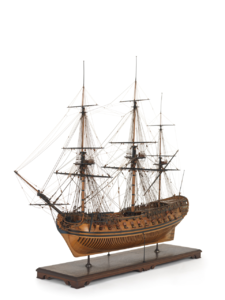
1780 – Launch of HMS Inflexible, a 64-gun third rate ship of the line of the Royal Navy,
HMS Inflexible was a 64-gun third rate ship of the line of the Royal Navy, launched on 7 March 1780 at Harwich.


1810 - Death of Cuthbert Collingwood
Vice Admiral Cuthbert Collingwood, 1st Baron Collingwood (26 September 1748 – 7 March 1810) was an admiral of the Royal Navy, notable as a partner with Lord Nelson in several of the British victories of the Napoleonic Wars, and frequently as Nelson's successor in commands
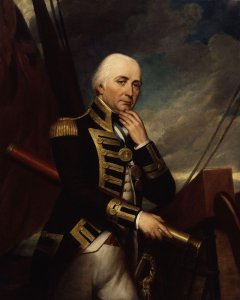
1860 – Launch of HMS Howe, a 121-gun screw first-rate ship of the line of the Royal Navy.
HMS Howe was built as a 121-gun screw first-rate ship of the line of the Royal Navy. She and her sister HMS Victoria were the first and only British three-decker ships of the line to be designed from the start for screw propulsion, but the Howe was never completed for sea service (and never served under her original name). During the 1860s, the first ironclad battleships gradually made unarmoured two- and three-deckers obsolete.

The former HMS Howe as the school ship HMS Impregnable in the 1890s.

Scale: 1:48. A contemporary full hull model of the 120-gun three-decked ship HMS ‘Howe’ (1860) mounted on its original wooden baseboard. It is complete with stump masts and bowsprit, two shortened funnels, a full set of guns mounted through their ports and a half bust gold-painted figurehead on the bow. The hull is finished in the traditional black and white striped colour scheme, with a coppered bottom, and a single screw mounted at the stern.
1864 – Launch of HMS Zealous, one of the three ships (the others being HMS Royal Alfred and HMS Repulse) forming the second group of wooden steam battleships selected in 1860 for conversion to ironclads
HMS Zealous was one of the three ships (the others being HMS Royal Alfred and HMS Repulse) forming the second group of wooden steam battleships selected in 1860 for conversion to ironclads. This was done in response to the perceived threat to Britain offered by the large French ironclad building programme. The ship was ordered to the West Coast of Canada after she was completed to represent British interests in the Eastern Pacific Ocean. Zealous became the flagship for the Pacific Station for six years until she was relieved in 1872. She was refitted upon her arrival and subsequently became the guard ship at Southampton until she was paid off in 1875. The ship was in reserve until she was sold for scrap in 1886.

HMS Zealous at Esquimalt with her sails set.
1901 – Launch of Duchesse Anne (formerly called Großherzogin Elisabeth), the last remaining full-rigged ship under French flag.
Duchesse Anne (formerly called Großherzogin Elisabeth) is the last remaining full-rigged ship under French flag. She was built in 1901 with a steel hull by the yard of Joh. C. Tecklenborg of Bremerhaven-Geestemünde (Germany) according to plans drawn by Georg W. Claussen. The mainmast is 48 m tall and 25 sails were rigged. She was used as a training ship for young aspiring sailors in the German merchant marine.

Sailing as Großherzogin Elisabethin 1913
1908 – Launch of SMS Nassau, the first dreadnought battleship built for the Imperial German Navy,
SMS Nassau was the first dreadnought battleship built for the Imperial German Navy, a response to the launching of the British battleship HMS Dreadnought. Nassau was laid down on 22 July 1907 at the Kaiserliche Werft in Wilhelmshaven, and launched less than a year later on 7 March 1908, approximately 25 months after Dreadnought. She was the lead ship of her classof four battleships, which included Posen, Rheinland, and Westfalen.

Nassau, very early in her career

Nassau and the rest of the I Battle Squadron in Kiel before the war
1941 – Günther Prien and the crew of German submarine U-47, one of the most successful U-boats of World War II, disappear without a trace.
German submarine U-47 was a Type VIIB U-boat of Germany's navy (Kriegsmarine) during World War II. She was laid down on 25 February 1937 at Friedrich Krupp Germaniawerftin Kiel as yard number 582 and went into service on 17 December 1938 under the command of Günther Prien.
During U-47's career, she sank a total of 31 enemy vessels and damaged eight more, including the British battleship HMS Royal Oak on 14 October 1939. U-47 ranks as one of the most successful German U-boats of World War II.

A model of U-47 viewed from the side
1989 – Launch of Kaiwo Maru (海王丸 Kaiō-Maru), a Japanese four-masted training barque tall ship. She was built in 1989 to replace a 1930 ship of the same name
Kaiwo Maru (海王丸 Kaiō-Maru) is a Japanese four-masted training barque tall ship. She was built in 1989 to replace a 1930 ship of the same name. She is 110.09 m (361.2 ft) overall, with a beam of 13.80 m (45.3 ft) and a depth of 10.70 m (35.1 ft). She is assessed as 2,556 GT. Propulsion is by two 4-cylinder diesel engines and a total of 2,760 m2 (29,700 sq ft) of sails. The engines have a total power of 3,000 horsepower (2,200 kW) and can propel the ship at a maximum of 14.1 kn (26.1 km/h; 16.2 mph), with a normal service maximum of 13 kn (24 km/h; 15 mph). Kaiwo Maru has a range of 9,800 nmi (18,100 km; 11,300 mi). The four masts are the fore mast, main mast, mizzen mast and jigger mast. The main mast is 43.50 m (142.7 ft). Her complement is 199

7th of March
please use the following link and you will find the details and all events of this day .....
Naval/Maritime History - 27th of August - Today in Naval History - Naval / Maritime Events in History
Today in Naval History - Naval / Maritime Events in History 6 March 1874 – Launch of The corbeta (corvette) ARA Uruguay, built in England, is the largest ship afloat of its age in the Armada de la República Argentina (Argentine Navy) The corbeta (corvette) ARA Uruguay, built in England, is the...
shipsofscale.com
1665 - HMS London (76) blew up in an accident and sank in the Thames estuary.
London was a 76-gun second-rate ship of the line in the Navy of the Commonwealth of England, originally built at Chatham Dockyard by shipwright John Taylor, and launched in June 1656. She gained fame as one of the ships that escorted Charles IIfrom Holland back to England during the English Restoration, carrying Charles' younger brother James Duke of York, and commanded by Captain John Lawson.
London was accidentally blown up in 1665 and sank in the Thames Estuary.[2] According to Samuel Pepys 300 of her crew were killed, 24 were blown clear and survived, including one woman. Lawson was not aboard at the time of the explosion but many of his relatives were killed.
The wreck of London
1757 – Launch of HMS Princess Amelia, an 80-gun third rate ship of the line of the Royal Navy
HMS Princess Amelia was an 80-gun third rate ship of the line of the Royal Navy, built at Woolwich Dockyard to the draught specified by the 1745 Establishment, and launched on 7 March 1757.
She participated in the 1781 Battle of Dogger Bank under the command of Captain Macartney with reduced masts and guns.
Princess Amelia was lent to the Board of Customs in November 1788, and thereby deleted from the Navy List. She arrived at Sheerness on 24 March 1818 from Stangate Creek. The Admiralty then sold her on 11 June 1818 to a Mr. Snooks for £2,610.
1765 – Launch of The San Zaccharia, a 64-gun ship of the line of the Navy of the Order of Saint John of Malta, later brought into French service as the Dégo.
The San Zaccharia was a 64-gun ship of the line of the Navy of the Order of Saint John of Malta, later brought into French service as the Dégo.
A model of an 18th-century third-rate of the Order of Saint John, similar to the San Zaccharia
1765 Launch of Artésien (“Artesian”), a 64-gun ship of the line
Artésien (“Artesian”) was a 64-gun ship of the line of the French Navy, lead ship of her class. She was funded by a don des vaisseaux donation from the Estates of Artois.
Artésien was built in 1765 as a part of a series of twelve ships of the line began by Choiseul to compensate for the losses endured by the French Royal Navy during the Seven Years' War. She was paid by the province of Artois and Flander, and named in its honour, according to the practice of the time.
Artésien took part in the American revolutionary war under Suffren, departing in 1781. Off Cape Verde, Artésien detected an English squadron, resulting in the Battle of Porto Praya.
Artésien was decommissioned in 1785 and used as a shear hulk.
A fine 1/28th scale model was used to instruct Louis XVI in naval studies. The model is now on display at the Musée de la Marine.
1778 - Continental frigate USS Randolph (32) explodes while attacking HMS Yarmouth (64) off the coast of Barbados, killing all but four of her 315 crew.
On the afternoon of 7 March, Randolph's lookouts spotted sail on the horizon. At 21:00 that evening, that ship, now flying British colors, came up on the Randolph as the largest ship in the convoy, and demanded they hoist their colors. The Randolph then hoisted American colors and fired a broadside into the British ship, mistakenly believing the ship to be a large sloop. The stranger turned out to be the British 64-gun ship of the line, HMS Yarmouth.
As a 64-gun, two-deck line-of-battle ship, Yarmouth had double the number of guns as Randolph. Yarmouth's guns were also significantly heavier, mounting 32 pound cannons on her main deck, 18 pounder guns on her upper deck and 9 pounder guns on her quarterdeck and forecastle, giving her almost five times the weight of shot that Randolph could fire. The Randolph and General Moultrie engaged Yarmouth until the Randolph's magazine exploded with a blinding flash. The Yarmouth was struck with burning debris up to six feet long, which significantly damaged her sails and rigging as well as killing five, and wounding twelve.
The damage caused to Yarmouth's sails and rigging prevented her from pursuing the remaining South Carolina ships which slipped away in the darkness.
The loss of the Randolph resulted in the deaths of 311 of her crew, including Capt. Nicholas Biddle, with 4 survivors.
The first USS Randolph was a 32-gun frigate in the Continental Navy named for Peyton Randolph.
HMS Yarmouth was a 64-gun third rate ship of the line of the Royal Navy, built at Deptford Dockyard. She was previously ordered to the dimensions specified in the 1741 proposals for modifications to the 1719 Establishment, but the Admiralty had very quickly concluded that these were too small, and as an experiment in 1742 authorised an addition of 6ft to the planned length, and the Yarmouth was re-ordered to the enlarged design in June 1742. She was built at Deptford, where the Admiralty felt they could best observe the effectiveness of the added size, and launched on 8 March 1745.

1780 – Launch of HMS Inflexible, a 64-gun third rate ship of the line of the Royal Navy,
HMS Inflexible was a 64-gun third rate ship of the line of the Royal Navy, launched on 7 March 1780 at Harwich.
1810 - Death of Cuthbert Collingwood
Vice Admiral Cuthbert Collingwood, 1st Baron Collingwood (26 September 1748 – 7 March 1810) was an admiral of the Royal Navy, notable as a partner with Lord Nelson in several of the British victories of the Napoleonic Wars, and frequently as Nelson's successor in commands

1860 – Launch of HMS Howe, a 121-gun screw first-rate ship of the line of the Royal Navy.
HMS Howe was built as a 121-gun screw first-rate ship of the line of the Royal Navy. She and her sister HMS Victoria were the first and only British three-decker ships of the line to be designed from the start for screw propulsion, but the Howe was never completed for sea service (and never served under her original name). During the 1860s, the first ironclad battleships gradually made unarmoured two- and three-deckers obsolete.
The former HMS Howe as the school ship HMS Impregnable in the 1890s.
Scale: 1:48. A contemporary full hull model of the 120-gun three-decked ship HMS ‘Howe’ (1860) mounted on its original wooden baseboard. It is complete with stump masts and bowsprit, two shortened funnels, a full set of guns mounted through their ports and a half bust gold-painted figurehead on the bow. The hull is finished in the traditional black and white striped colour scheme, with a coppered bottom, and a single screw mounted at the stern.
1864 – Launch of HMS Zealous, one of the three ships (the others being HMS Royal Alfred and HMS Repulse) forming the second group of wooden steam battleships selected in 1860 for conversion to ironclads
HMS Zealous was one of the three ships (the others being HMS Royal Alfred and HMS Repulse) forming the second group of wooden steam battleships selected in 1860 for conversion to ironclads. This was done in response to the perceived threat to Britain offered by the large French ironclad building programme. The ship was ordered to the West Coast of Canada after she was completed to represent British interests in the Eastern Pacific Ocean. Zealous became the flagship for the Pacific Station for six years until she was relieved in 1872. She was refitted upon her arrival and subsequently became the guard ship at Southampton until she was paid off in 1875. The ship was in reserve until she was sold for scrap in 1886.
HMS Zealous at Esquimalt with her sails set.
1901 – Launch of Duchesse Anne (formerly called Großherzogin Elisabeth), the last remaining full-rigged ship under French flag.
Duchesse Anne (formerly called Großherzogin Elisabeth) is the last remaining full-rigged ship under French flag. She was built in 1901 with a steel hull by the yard of Joh. C. Tecklenborg of Bremerhaven-Geestemünde (Germany) according to plans drawn by Georg W. Claussen. The mainmast is 48 m tall and 25 sails were rigged. She was used as a training ship for young aspiring sailors in the German merchant marine.
Sailing as Großherzogin Elisabethin 1913
1908 – Launch of SMS Nassau, the first dreadnought battleship built for the Imperial German Navy,
SMS Nassau was the first dreadnought battleship built for the Imperial German Navy, a response to the launching of the British battleship HMS Dreadnought. Nassau was laid down on 22 July 1907 at the Kaiserliche Werft in Wilhelmshaven, and launched less than a year later on 7 March 1908, approximately 25 months after Dreadnought. She was the lead ship of her classof four battleships, which included Posen, Rheinland, and Westfalen.
Nassau, very early in her career
Nassau and the rest of the I Battle Squadron in Kiel before the war
1941 – Günther Prien and the crew of German submarine U-47, one of the most successful U-boats of World War II, disappear without a trace.
German submarine U-47 was a Type VIIB U-boat of Germany's navy (Kriegsmarine) during World War II. She was laid down on 25 February 1937 at Friedrich Krupp Germaniawerftin Kiel as yard number 582 and went into service on 17 December 1938 under the command of Günther Prien.
During U-47's career, she sank a total of 31 enemy vessels and damaged eight more, including the British battleship HMS Royal Oak on 14 October 1939. U-47 ranks as one of the most successful German U-boats of World War II.
A model of U-47 viewed from the side
1989 – Launch of Kaiwo Maru (海王丸 Kaiō-Maru), a Japanese four-masted training barque tall ship. She was built in 1989 to replace a 1930 ship of the same name
Kaiwo Maru (海王丸 Kaiō-Maru) is a Japanese four-masted training barque tall ship. She was built in 1989 to replace a 1930 ship of the same name. She is 110.09 m (361.2 ft) overall, with a beam of 13.80 m (45.3 ft) and a depth of 10.70 m (35.1 ft). She is assessed as 2,556 GT. Propulsion is by two 4-cylinder diesel engines and a total of 2,760 m2 (29,700 sq ft) of sails. The engines have a total power of 3,000 horsepower (2,200 kW) and can propel the ship at a maximum of 14.1 kn (26.1 km/h; 16.2 mph), with a normal service maximum of 13 kn (24 km/h; 15 mph). Kaiwo Maru has a range of 9,800 nmi (18,100 km; 11,300 mi). The four masts are the fore mast, main mast, mizzen mast and jigger mast. The main mast is 43.50 m (142.7 ft). Her complement is 199



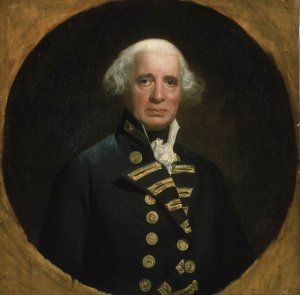

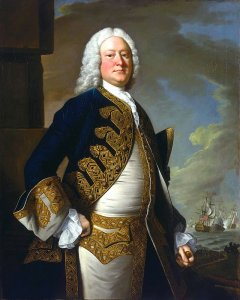
 Shipbuilding and Drydock Company
Shipbuilding and Drydock Company
